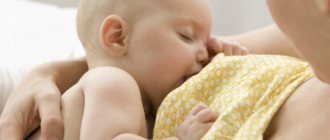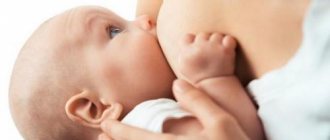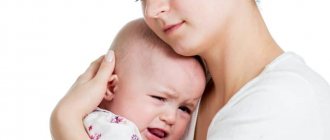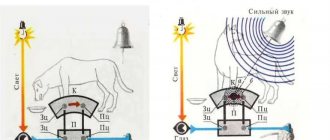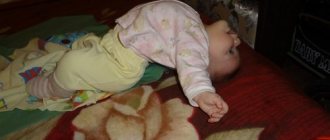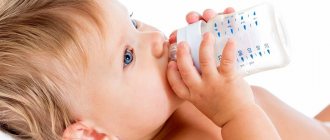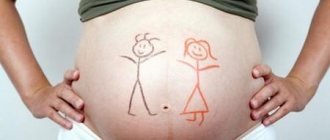The Moro reflex in newborns is used in the diagnosis of neurological disorders. Parents should not deliberately evoke this reflex and provoke fear in the child. What stimulates reflex action:
- sharp sound or noise, loud scream;
- quick movement of the hand towards the child’s face;
- entering the field of view of any fast moving and potentially dangerous object that moves towards the baby, for example a jumping cat;
- hitting the surface on which the child is lying, for example, slapping the palm of your hand on a table.
A stimulus can be any action that the infant perceives as a likely threat to its physical safety.
Some parents play jokes on their children, scaring them and triggering the Moro reflex. For a newborn, such jokes are not funny enough, because he really experiences the horror of the situation.
Reflexes of newborn children: how they manifest themselves, timing of extinction
A child is born with a certain set of innate reflexes. In the past, they allowed the baby to survive, but now they serve as an indicator of normal development.
Neonatal reflexes of newborn children are formed during intrauterine development, thanks to them the newborn unconsciously performs actions necessary for survival, which function and gradually fade away until the sixth month of life. If they persist longer, this may indicate an immature nervous system at best, and developmental abnormalities at worst. Preservation of primitive reactions for more than a year leads to a violation of the behavior pattern that dominates consciousness.
Sucking and swallowing
The newborn practices these actions while still in the cozy tummy of the mother; later they help him eat and help relieve stress. The sucking reflex weakens closer to three years, as a rule, this coincides with the cessation of breastfeeding. At the same age, the baby independently refuses the pacifier; returning to it is possible in stressful situations.
Search reflex
If you touch the cheek or corner of the mouth, the newborn will turn its head towards the stimulus and open its mouth in search of the mother's breast.
The reaction weakens after feeding and disappears completely after the third month of life.
Persistence of searching for longer periods of time is associated with tactile hypersensitivity in the mouth and immature nervous system, which makes it difficult to develop the correct movements for eating solid food.
Moro reflex
Sometimes also called the startle or hug reflex, which develops in the third trimester of pregnancy and may be absent in children born prematurely.
Likely a remnant of the original urge to grab the mother in a moment of danger, the fight and flight response is activated, releasing stress hormones. In other words, it is an automatic response to a loud sound or sudden movement nearby.
When frightened, the baby sharply throws his arms up, and an expression of surprise or fear appears on his face.
Normally, it fades away after the fourth month of life; longer functioning indicates increased sensitivity of the nervous system. The preserved reaction prevents contact with the outside world or, on the contrary, the traits of excessive activity and a tendency to dominate are acquired.
Grasping reaction
If you touch the palm of a newborn, he will clench his fingers into fists, trying to grab the stimulus; the newborn can be lifted above the table surface when he grabs the fingers of an adult (Robinson reflex). Unextinguished after the first half of the year, it leads to speech impairment and unformed fine motor skills; the reason for the delay in congenital action may be hypersensitivity of the palms.
Asymmetrical cervical tonic
Effective from the 18th week of fetal life and lasts until the sixth month of life. When a newborn turns his head, his arms and legs on the side of the face remain straight, and on the side of the back of the head they bend. This is a very important reflex because it trains the fetal muscles and facilitates the process of passage through the birth canal. It also promotes flexibility in the hip joints and shoulder girdle.
A newborn who does not lose this reflex will have problems with crawling and walking - the baby may use his right leg and left arm as dominant, which is why he will perform unilateral movements instead of alternating ones when walking or jumping. A pronounced asymmetric cervical tonic reflex may be a sign of cerebral palsy.
Galant reflex
Newborn babies' reflexes include reactions to touch. It forms after the 20th week of pregnancy and disappears between 3 and 9 months.
When someone touches the back of a baby lying on his tummy, he arches his back towards the stimulus. The reflex should be the same on both sides of the back.
Preservation negatively affects gait and also contributes to the development of scoliosis.
Gait reflex
A newborn shows the first steps in an upright position with support under the arms, but this skill has nothing to do with real walking. This gait disappears within a few months after birth.
If it remains after the first half of the year, it may be a consequence of hypertension. Some parents deliberately do not allow the reflex to fade, believing that this will speed up the approach of the first independent steps.
However, these actions lead to problems with the formation of the natural curves of the foot and spine.
Babinski reflex
Irritation of the skin on the outer edge of the sole causes automatic straightening and flexion of the toes; in adults and older children the reflex shows serious impairment, but in young children it is a natural phenomenon. Normally, it appears at 2-3 weeks of age or later and disappears in about a year.
Gag reflex
The newborn uses his tongue to push out hard objects to protect his airway. The gag reflex fades away by 5-6 months. Earlier decline is due to teething and active cognitive function. If it persists for more than six months, it will be difficult for the child to switch to a new type of food.
Defensive reactions
Some reflexes in newborns are automatic, they are designed to protect against health threats. So, a newborn will turn his head to the side when he is placed on his tummy, hold his breath if you direct a stream of water on his face, and close his eyes if you blow on him. The listed reactions may be absent in children with damage to the nervous system.
Reflexes are checked in the maternity hospital; if some of them are absent, weakly or excessively expressed, the doctor assumes a developmental disorder; in premature babies, the severity of congenital reactions is weaker, so only a specialist makes the diagnosis here. When a neurologist, after a preventive examination, says that the newborn is healthy, parents should trust him or, if in doubt, consult another specialist.
Source: https://maminmayak.ru/osnovnyie-refleksyi-novorozhdennyih-kak-proyavlyayutsya-sroki-ugasaniya/
What parents should know about the Moro reflex in infants
Dr. Moreau was the first to describe this child’s reaction to external stimuli in his writings after the 1st World War.
A German specialist, a pediatrician, evoked this reflex with successive loud blows on the surface, unexpected for the baby, near the child’s head. He described it as the primary manifestations of natural instincts, when, when frightened, the child seems to capture the mother, protecting himself from external stimuli.
Quite often, doctors themselves call the Moro reflex a fear reaction - its essence is that the child reacts to a blow by symmetrically spreading his arms to the sides.
The child straightens his fingers and in this position can maintain the body position for several seconds, then returning his hands to their original position, clenching their fingers into fists. Quite often, this reaction can be accompanied by the baby crying.
With normal growth and development of the infant, the Moro reflex fades away and completely disappears by 2-4 months, less often by six months, but if it is diagnosed in a child after 6 months of age, this indicates the presence of problems with the child’s health, in particular with the peripheral and central nervous system. system.
The importance of this reflex lies in the fact that it indicates the degree of development, the presence or absence of deviations in the functioning of the baby’s nervous system, and its adaptation to the outside world.
In its intensity, it clearly manifests itself immediately after childbirth, gradually fading away by six months, but if this does not happen, this indicates problems with the central nervous system.
Accordingly, the child should be shown to a neurologist.
How is the reaction checked?
This reflex is checked by pediatricians after the birth of the child and this is done quite simply; even the parents themselves can conduct such testing. The test is as follows:
- At a distance of 15-20 centimeters from the place where the newborn’s head lies, they hit the flat surface of the crib with their hand or clap their hands at ear level. This is exactly what Moro himself did, after whom the reflex is named, but the reaction can also manifest itself to a sharp and loud sound, to sudden movements.
- As a response, the child makes the following movements - he spreads his arms in different directions, opens his palms, then pulls them towards him, trying to grab onto something. At this moment, the baby’s legs may reflexively pull up towards the stomach or straighten - this reaction is considered normal.
The reaction manifests itself in two phases - first, the baby will move back, leaning slightly, straightening his shoulders, then spread his limbs in different directions, straightening his fists. The second stage of the reflex - takes the previous, original position, the fetal position.
The nervous reaction in a newborn should be symmetrical, both on the left and on the right side - if it is absent, then we are talking about asymmetry of the Moro reflex.
Quite often, this reflex manifests itself in children during sleep - even the slightest noise or sound can frighten him, when the child will automatically react to them by crying and throwing his arms to the sides. It is not possible to eliminate such manifestations - it is recommended to simply minimize all noise, sharp sounds and knocking.
What is normal and pathological?
The reflexes of a newborn are checked by a neonatologist on the first day after birth, and then monitored by a pediatrician.
https://www.youtube.com/watch?v=FWrVB_2U5bY
The normal manifestation of the Moro reflex in an infant is the appearance of the latter in response to external stimuli at the age of 4-6 months, but when a strong sound is left without special attention after this period.
The reaction to the stimulus is also accompanied by the following symptoms:
- increased heart rate and release of adrenaline into the blood;
- frequent inhalation and exhalation;
- strong and loud crying.
This is also the norm, and goes away on its own after a few minutes - the reflex itself completely disappears in the baby before six months. Otherwise, we are talking about pathology, a deviation in the normal development of the child and requires surgical intervention by doctors and the prescription of an appropriate course of treatment.
As noted earlier, this reflex in a newborn goes away before six months of age, but if its manifestations are diagnosed after 6 months, this indicates damage to the cerebral cortex.
If the baby is healthy, then at a loud sound he will spread his arms and legs to the sides symmetrically, straightening his fingers and returning to his previous position.
When diagnosing an intracranial injury received during childbirth, this reflex will be absent in the infant, indicating depression of the central or peripheral nervous system.
If hypertension is pronounced, the Moro reflex will not fully manifest itself when the child only slightly moves his arms to the sides. If the central nervous system is damaged, the child will hold his hands for a long time, with his fingers open, in an extended position.
If an asymmetric reflex is diagnosed, when the child moves one arm or leg to the side, or its complete absence, this indicates the development of cerebral palsy or Erb's palsy, hemiparesis is possible. All this is a consequence of damage to the central or peripheral nervous system.
When there is a simultaneous absence or a sharp decrease in two or more reflexes - grasping, Babkin, Moreau, this indicates the development of severe damage to the gray matter of one or another part of the brain.
If the baby does not respond to external stimuli for a long time, or if it decreases, the newborn must be shown to specialists.
What is this?
The Moro reflex is one of the unconditioned reflexes that appears immediately after birth (it can be seen when the obstetrician treats the baby). It was first described by the German pediatrician Moreau in 1918, after whom automatism is named. It is important to understand that this is not a pathological reflex, but an absolutely normal reaction of a healthy newborn.
You can learn more about the reflexes of a newborn in the following video.
How to trigger and evaluate the reflex
To trigger the Moro reflex you can:
- Suddenly hit the surface with both hands 15-20 centimeters from the head of the child lying on it (on both sides).
- Suddenly straighten the legs of a baby lying on his back or lift the baby’s unbent legs along with the pelvis.
- Take the baby in your arms and sharply lower him in your arms 20-30 cm down, and then return him to his original height.
- Sharply clap your hands next to the lying child.
The reaction to such techniques is divided into two phases:
- In the first phase, the baby moves his shoulders and arms to the sides, while opening his fists (fingers spread out).
- In the second phase, the baby’s arms return to the position in which they were before the impact (the baby seems to be hugging something or hugging someone).
How to assess the reflex and why a baby should be swaddled, see the following video.
Because of such manifestations, this reflex is also called the startle reflex. It often appears during sleep if the baby is frightened by some noise, for example, a pet or the sound of a car from an open window. It can also occur with sudden movements of an adult who is holding the baby in his arms. This does not harm the baby in any way, but can cause prolonged crying.
It is important to note that the reflex manifests itself symmetrically on both sides, that is, the baby raises and spreads both arms equally. In healthy infants, the Moro reflex is preserved until 3-5 months of age, after which it gradually fades away. In babies older than 5 months, only individual components of this reflex are normally noted.
Check Features
- The reflex is often checked in the morning, about 2 hours after feeding.
- The result is determined by the symmetry and severity of the reflex. It may be bright, normal, weak or absent.
- The speed of manifestation is also assessed, according to which the reflex can appear quickly or be delayed.
- The test is performed dynamically.
- When assessing the result, it is important to take into account the baby’s health and the excitability of his nervous system, as well as whether the baby is full and tired.
Remember that during the test the baby feels stress, as the baby becomes scared due to the fall and he tries to save himself by grabbing onto his mother or the surface. Even if you think it looks very funny, you should not provoke the appearance of such a reflex on purpose if it is not required for a medical examination of the baby.
To eliminate the frequent occurrence of the reflex, it is advised:
- Do not make sudden gestures near the baby or when the baby is in your arms.
- Try to limit the level of noise affecting the toddler.
- Talk to the baby in a gentle and calm voice.
Source: https://yazdorov.win/beremennost/chto-dolzhny-znat-roditeli-o-reflekse-moro-u-grudnichkov.html
How does the Moro reflex manifest itself?
In response to a stimulus from the outside world, the newborn performs a sequence of actions with his hands, which are divided into 2 phases:
- First phase. Symmetrical abduction of both arms to the side, opening of the palm. The duration of the first phase takes from a few fractions of a second to 2-3 seconds.
- Second phase. Symmetrically bringing the arms to the starting position, clenching the fists.
The biological meaning of this reflex is not completely clear, but experts suggest that it is a type of grasping movement. Some innate reflexes do not persist throughout a person’s life, but disappear by a certain age. Moro reflex:
- observed from the moment of birth and used in obstetric practice to diagnose neurological pathologies;
- eliminates itself as the child grows older;
- usually goes away by 3-5 months, in most children it disappears at 4 months.
Why you can’t deliberately scare a child in order to see how he clasps and unclenches his hands:
- during fright, the baby’s endocrine system releases a large amount of adrenaline, norepinephrine and related hormones into the blood;
- these substances constrict blood vessels, increase blood pressure, increase heart rate, and stimulate blood flow to the muscles;
- The entire complex of a child’s experiences in physiological manifestations fully corresponds to the strong feeling of fear in an adult.
The child does not have developed abstract thinking, so he cannot understand that there is no threat to life. Every comic action of his parents frightens him as if he were in real danger. After the Moro reflex, the child:
- cries and screams a lot;
- is in a state of psychomotor agitation;
- moves his arms and legs chaotically.
These signs indicate stress you have just experienced. In order for the child to calm down, you need to take him in your arms, talk in a gentle voice or sing a song.
Moro reflex in newborns
- The essence of the reflex
- What is considered normal
- What should you be wary of?
Reflexes play an important role in human life. They can be conditional or unconditional, congenital or acquired, but one way or another they are the main form of activity of the nervous system.
A newborn, when born, has its own set of physiological innate reflexes, about 15 of them.
They help him adapt to the world around him, because at this stage he does not understand much, the child has not yet formed behavioral stereotypes.
Each reflex in infancy has its own important goal: to protect (Moro reflex), satisfy the need for nutrition (sucking, proboscis, searching), and provide the opportunity to breathe freely. In this article we will look at how the Moro reflex manifests itself in newborns, its characteristics and the time of extinction.
The essence of the reflex
The Moro reflex can be observed immediately after birth. Thus, obstetricians and neonatologists test the baby for various reactions, which, in turn, can show the state of the nervous system and whether there are any abnormalities in brain activity.
The essence of the test is as follows: the baby is placed on a flat, hard surface on his back. Then the doctor hits the surface with his hand at a palm distance (about 15 cm) from the baby’s head or makes a loud bang.
As a response, the baby's arms sharply throw back, he moves them symmetrically to the sides, straightening his fists. This is the so-called first phase of the reflex, lasting several seconds.
In the second phase, the handles slowly return to their original position, the cams are compressed.
When testing the Moro reflex, a baby's crying is normal.
Similar symptoms are also observed if a baby is held in your arms, lifted up, and then sharply lowered down. Another check is this: the legs of a baby lying on his back are straightened and they are lifted together with the pelvis, as if upward. The reaction with handles will be the same.
When does the reflex go away? Complete extinction occurs at approximately 6 months. Up to 4 months it is quite well expressed, and from 4 to 6 only its individual fragments can be observed.
What should be the conditions for assessing the Moro reaction? It is very important that at the time of the test the baby is calm, moderately full (recommended in the morning - 2 hours after feeding) and healthy.
What is considered normal
During the test, the following reaction in a baby is considered normal:
- fright, crying of a baby;
- rapid heartbeat, increased breathing;
- release of adrenaline into the blood.
We recommend reading: Sucking reflex in newborns
This is the norm, since these manifestations indicate that the central nervous system (CNS) reacts correctly and quickly. The Moro reflex in a newborn can be observed in everyday life, for example, with loud noises on the street, the doorbell rings, and sometimes the child may flinch in his sleep.
Despite all the so-called “norms” of the study, it should be understood that at the moment of flinching and spreading the arms, a strong fear occurs, as if the baby is trying to grab onto his mother or someone close, feeling danger.
Therefore, it would be wrong to show “tricks” with your child to friends and acquaintances, every now and then causing manifestations of the reflex for the purpose of entertainment.
Rather, on the contrary, it is necessary to try to minimize the possible causes of fear and eliminate irritating factors that can negatively affect the child’s psyche.
At the same time, there is no need to worry too much if you notice that when hearing sharp sounds, the baby opens its arms and begins to cry.
What should you be wary of?
When assessing the baby’s reaction, pay attention to the severity of the reflex effect: it is weak, normal or too bright, appears quickly or late, etc. If deviations from the norm are noticed, the child is sent for examination. The following factors should be of concern:
Asymmetry. During the test, the handles do not recline symmetrically. This is a bad sign for any reflex, as it indicates intracranial injury or problems with the central nervous system.
Asymmetry is often observed in neurological syndromes, such as paresis.
We can say that paresis is an incomplete paralysis in which the motor pathways of the nervous system are damaged, as a result of which motor activity is limited.
Spontaneous reflex. It is expressed by the fact that the baby moves his arms to the sides even in the absence of cotton or any other irritant. This may indicate the development of intracranial pressure, so neurosonography and other examinations are required.
Obstetricians and neonatologists check the reflex reactions of a newborn in his first minutes of life
The absence of a reflex occurs when brain activity is damaged and is detected in the delivery room. Often in such cases, several reflexes are suppressed or completely absent, and the newborn has a low Apgar score. This can happen during difficult childbirth, extreme prematurity, or oxygen starvation of the fetus.
Incomplete reflex. It is observed when the baby throws his arms back slightly and indicates the development of hypertension. The specialist is able to assess the threshold of the Moro reflex. The lower it is, the greater the likelihood of damage to the central nervous system. In children with brain disorders, reflex activity may not fade away for a long time.
With severe brain disorders, as well as with malfunctions of the central or peripheral nervous system, reflex damage will not be the only symptom.
The child is additionally examined by neurologists and neonatologists and, depending on the diagnosis and severity of the disease, treatment is prescribed.
Often the treatment regimen includes a course of massage, which helps relieve muscle tone, as well as taking nootropic drugs that improve cerebral circulation.
Fortunately, in most cases, the reflexes of young children work smoothly and do not cause any concern.
Source: https://floragaz.ru/zdorovye/refleks-moro-novorozhdennyh-detey
Panic reflex and Moro reflex
The two reflexes we will talk about today are related to each other. The reflex of paralyzing (or panic, depending on the translation) fear - RPS - occurs in the fetus in the womb in the 1st trimester of pregnancy. It is necessary for the mother and fetus in case of danger: when a stressful situation arises, the child literally “freezes,” the placenta restricts the flow of blood with stress hormones from the mother, and the mother frees up resources to fight the external enemy and survive (the notorious fight reaction or escape). Normally, this reflex is integrated into the well-known Moro reflex, which is active in infants from birth to 4 months. The Moro reflex is also associated with the reaction to danger, but of an already born child. The child reacts to auditory, visual and vestibular information (spreads his arms to the sides, unclenches his fists and then brings them back, making a grasping movement). However, in some cases, the RPS and the Moro reflex do not go out, but continue to be active. Risk factors may be associated with pregnancy and childbirth (stress during pregnancy, threat of miscarriage, premature birth, cesarean section, obstetric procedures, asphyxia, hypoxia, etc.). These two reflexes often remain active in pairs, because biologically related. In practice, it can be seen from the child’s profile that the predominant factor is r. Moro or RPS (there will be different “portraits” of children).
Consequences of violation of the integration of the RPS and the river. Moro:
- Hypersensitivity in auditory, visual, tactile modalities, as well as possible gravitational uncertainty;
- Eye contact may be impaired;
- Visual information processing disorder, “does not see” things directly in front of you;
- Avoidance of social contact, communication difficulties;
- Low stress resistance;
- Expressive verbal impairments;
- Extreme anxiety, fears, phobias, panic attacks;
- Impulsivity, tendency to aggression (Moro R.);
- Difficulties in switching activities.
As we see, the consequences concern various areas of development. And this “portrait” includes children with ASD and children with so-called emotional-volitional immaturity, anxious children.
Active RPS and r. Moros make it difficult, according to the “falling domino principle,” to integrate other reflexes, as well as the entire psychological and pedagogical correction in general. These are precisely the children with whom it is difficult to establish contact, to form a trusting basis for classes, children who run out of the office and throw tantrums. Therefore, integration work is carried out with these two reflexes first, and then subsequent sets of exercises are carried out for other reflexes.
The first person I diagnosed with RPS and r. Moreau, was my son. This is exactly the case when I, as a mother, “contained, but did not uncontain.” That is, for a child with RPS it is almost impossible to form the notorious “basic trust in the world” according to Petranovskaya, since a panicky fear of this very world was formed in utero. This was a revelation for me. “Classical” psychology is an excellent tool, but without working with reflexes, psychotherapy will be ineffective and long-lasting. And this is not mysticism or esotericism, but biology. Unfortunately, I did not find Russian-language sources on these reflexes. Recommended book in English: The Symphony of Reflexes: Interventions for Human Development, Autism, ADHD, CP, and Other Neurological Disorders, by Bonnie Brandes.
To integrate the RPS and the Moro reflex, it is necessary to perform a set of special exercises daily that activate the reflex and then extinguish it. I show these exercises at the reception and ask parents to do them every day. After 1 week of exercises with my son, I already see a wonderful effect. Egor began to control his emotions better and communicate more confidently. There were much fewer hysterics, and resistance to frustrating factors improved (in stories I told how we went to the dentist on Friday). It became much easier to negotiate with him.
Neuropsychologist Alexandrova O.A.
To schedule a consultation with a specialist, call or fill out the application form on the website.
You can also contact us through popular messengers:
What is spontaneous Moro syndrome?
Immediately after birth, obstetricians or neonatologists, in addition to the mandatory general examination, check the newborn for a series of unconditioned congenital reflexes.
Their presence not only provides the baby with adaptive functions from the first minutes of life, but also speaks about his health.
The Moro reflex, along with the others, has been included in the list of mandatory checks for a child after birth for many years.
The essence of the reflex in children
The Moro reflex - in simple words, the fear reflex - is one of the innate unconditioned reflexes in a child in the first months of life. Normally, the reflex reaction to a potential threat is completely replaced by a conscious response by the age of six months.
The essence of the reflex is the baby’s response to a loud sound that is unexpected for him in the form of throwing up and spreading his arms wide to the sides. At the same time, the fingers of the hand are extended, and the pose is maintained for several seconds. After this, the hands return to their original position, the fists clench again, and the child tries to assume the fetal position.
Note! Such testing often provokes the baby to cry, which is completely normal.
How is the reaction in a newborn checked?
Before testing begins, the child must be completely healthy, reasonably fed and well rested.
The most optimal time is the first half of the day, 1.5-2 hours after feeding.
The reflex is tested in several ways:
- Clap your hands loudly in front of the baby's face.
- The child is picked up, lifted up, and then sharply lowered down.
- The newborn lies on his back. The child's legs are straightened and sharply raised upward along with the pelvis. The response should manifest itself in a similar way if you press the baby’s arms tightly to his chest and then abruptly release them.
- At a distance of approximately 20 cm from the head of the lying child, make a sharp clap on the surface of the mattress.
During any of the listed test options, the child opens his arms wide to the sides with open palms, and then returns them to their original position. The mechanism of action is very similar to the fact that the baby is urgently trying to grab onto someone or something at this moment of perceived danger.
It is best to conduct dynamic testing during a massage or playing with a child. It is definitely worth taking into account the peculiarities of the child’s nervous activity.
How bright the reflex is will depend on this.
For example, an easily excitable baby will have an active reaction, while a phlegmatic baby may react rather sluggishly, but this is still not a reason to talk about deviations from the norm.
It is advisable to repeat the test periodically for as long as the reflex should be present: until the baby is 6 months old. The best option is once every 14 days.
Reference. The initial purpose of testing is to check the full functioning of the child’s central and peripheral nervous system. The manifested reflex causes a high degree of stress in the baby with the release of adrenaline, rapid breathing and heartbeat.
No matter how comical the child may look, it is strongly not recommended for young parents to use such a test for fun.
Manifestation in a dream in a baby
The Moro reflex during sleep manifests itself in the form of spontaneous twitching and this is a fairly common phenomenon.
Involuntary sudden movements can appear at any, even the deepest, phase of the baby’s sleep.
The reflex can be triggered by loud sounds made by pets, any noise, or a careless sudden movement of one of the parents.
Over time, the baby's violent reaction to external stimuli will fade away more and more, and the reflex will manifest itself only selectively.
Until what age should it pass?
Depending on the individual characteristics of each newborn, the Moro reflex occurs between 4 and 6 months of life. Reflex reactions gradually fade away, and by the age of six months, with full development and health of the baby, they should go away completely.
Pathological manifestations
The Moro reflex is also characterized by spontaneous manifestations. Even if any external irritant could not cause such a reaction, the baby can throw up his arms and spread them to the sides. In some cases, this indicates increased intracranial pressure in the infant and requires consultation with a neurologist.
An incomplete reflex reaction is also considered a deviation from the norm: the child only slightly spreads his arms. As a rule, this indicates hypertension. If the baby holds his arms apart for a long time with his fingers open, this is a sign of damage to the central nervous system to one degree or another. And the lower the threshold for the manifestation of the reflex, the higher the likelihood of problems with the central nervous system.
An asymmetric reaction, when the baby moves to the side, for example, only the right arm and right leg, may be a symptom of Erb's palsy or cerebral palsy.
In premature babies or those who have experienced asphyxia during childbirth, the reflex may appear late. With timely treatment measures, proper care and nutrition, the reaction will manifest itself over time.
If missing
The complete absence of the Moro reflex in a baby is almost always detected in the delivery room and is a sign of serious damage to brain activity.
As a rule, in this case, a number of reflexes are suppressed and the Apgar score is low.
This is a widespread phenomenon in acute oxygen starvation of the fetus, extreme prematurity, or due to severe problematic labor.
The absence of a reflex indicates one of these problems:
- pathologies of the cervical vertebrae;
- brain stem damage;
- cerebral hemorrhages;
- cerebral edema.
Attention! All of the listed possible pathologies are serious cerebral lesions that require immediate and adequate treatment.
The child should be under systematic supervision of a pediatrician and neurologist. All kinds of testing for reflexes in infants are indicators of the health of their nervous system. And this is a good reason to begin eliminating the existing problem immediately in order to avoid even more severe complications in the near future.
We recommend that you watch a useful video about reflexes in children:
Reflexes play an important role in human life. They can be conditional or unconditional, congenital or acquired, but one way or another they are the main form of activity of the nervous system.
A newborn, when born, has its own set of physiological innate reflexes, about 15 of them.
They help him adapt to the world around him, because at this stage he does not understand much, the child has not yet formed behavioral stereotypes.
Source: https://eltransteh.ru/spontannyj-sindrom-moro-chto-jeto/
Moro reflex - features of testing the fear reaction in newborns
Those who have not yet become parents may mistakenly perceive a newborn as a creature that just needs to be fed, bathed and, after being lulled to sleep, put to sleep.
However, a newborn, like an adult, is a complex, living organism, with a whole set of reflexes that helped them survive earlier and adapt to the world around them now.
Many young parents may be frightened by the unexpected and sharp throwing up of arms and loud crying in a newborn - manifestations of the so-called Moro reflex. It is also often called the startle reflex, and will be discussed further.
Primary characteristic
Dr. Moreau was the first to describe this child’s reaction to external stimuli in his writings after the 1st World War.
A German specialist, a pediatrician, evoked this reflex with successive loud blows on the surface, unexpected for the baby, near the child’s head. He described it as the primary manifestations of natural instincts, when, when frightened, the child seems to capture the mother, protecting himself from external stimuli.
Quite often, doctors themselves call the Moro reflex a fear reaction - its essence is that the child reacts to a blow by symmetrically spreading his arms to the sides.
The child straightens his fingers and in this position can maintain the body position for several seconds, then returning his hands to their original position, clenching their fingers into fists. Quite often, this reaction can be accompanied by the baby crying.
With normal growth and development of the infant, the Moro reflex fades away and completely disappears by 2-4 months, less often by six months, but if it is diagnosed in a child after 6 months of age, this indicates the presence of problems with the child’s health, in particular with the peripheral and central nervous system. system.
The importance of this reflex lies in the fact that it indicates the degree of development, the presence or absence of deviations in the functioning of the baby’s nervous system, and its adaptation to the outside world.
In its intensity, it clearly manifests itself immediately after childbirth, gradually fading away by six months, but if this does not happen, this indicates problems with the central nervous system.
Accordingly, the child should be shown to a neurologist.
How to get adequate results?
When conducting diagnostics and determining the level of development of the baby’s reflexes, it is necessary to take into account the following factors and basic positions:
- physiological, general condition of the baby - he should be well-fed, rested and not overexcited in any way, the general state of health must also be taken into account, whether he is tired or not, healthy or sick, and if he is not feeling well, it is recommended to postpone the study;
- the Moro reaction is checked in the dynamics of its manifestation, not limited to a single test - it is best if this is done in the morning, 1.5-2 hours after feeding;
- The characteristics of nervous activity and the level of excitability of the child are taken into account.
When assessing the results, the main thing to pay attention to is how pronounced the fear reaction is, the timing of the first and second phases.
The characteristics of the reaction give an idea of how adapted the child is to the world around him.
Sometimes parents can observe a spontaneous Moro reflex in a baby - this means that the baby can throw his arms to the sides, opening and closing his fingers even in the absence of both internal and external stimuli. It is recommended to show the child to a neurologist and pediatrician, as this may indicate numerous health problems.
You can be calm
For the most part, young mothers and fathers can sleep peacefully and not worry, since the startle reflex is an absolutely normal reaction of babies to external and internal stimuli.
The main thing that parents should remember is not to go to extremes and not to be constantly touched by the behavior of their child, amusing themselves with a game of get-together.
Quite often, parents make one unforgivable mistake - by loud claps next to the baby, they force his legs and arms to throw up.
This should never be done, this reflex is caused by strong emotions, fear and stress, and its frequent manifestation can provoke numerous problems with the nervous system in the future.
Source: https://clinica-opora.ru/%D0%BD%D0%B5%D0%B2%D1%80%D0%BE%D0%BB%D0%BE%D0%B3%D0%B8%D1 %8F/%D1%80%D0%B5%D1%84%D0%BB%D0%B5%D0%BA%D1%81-%D0%BC%D0%BE%D1%80%D0%BE-% D0%BE%D1%81%D0%BE%D0%B1%D0%B5%D0%BD%D0%BD%D0%BE%D1%81%D1%82%D0%B8-%D0%BF%D1 %80%D0%BE%D0%B2%D0%B5%D1%80%D0%BA%D0%B8-%D1%80/
Moro reflex in a newborn is normal
The Moro reflex in a newborn appears immediately after birth and is one of the criteria for assessing a child by neonatologists. However, its course is so specific that inexperienced parents mistake the natural movements of the newborn for pathology. But let's get back to our story.
Suspicions began to torment Alla after Sofia's energetic young uncle decided to attract her attention by snapping his fingers. In response, the baby stretched out her legs, raised them above the changing table, spread her arms to the sides and even unclenched her fists. This tense body position was maintained for several seconds. We called a doctor we know. Having asked about what happened, he ordered to approach the baby again and clap his hands loudly. The picture repeated itself! And the doctor talked about the Moro reflex, which, in fact, we observed. The Moro reflex is expressed immediately after birth. It can be noticed even during the midwife’s manipulations in the delivery room! The Moro reflex in a newborn usually lasts up to 4–5 months, then disappears.
